There is a signal strength icon on the bar to the left of the clock. If you don't see it, you can scroll through the icons using the blue arrows. Once you have found the icon, double-click on it and the Laird Connection Manager will open.
2) In the manager, move to the second tab "Configuration".
3) Click on the "Scan" button here.

4) After opening the scan, wait a few minutes for the terminal to display all networks in range.
5) Select your network and click on "Configure".

6)
When asked if you want to create a new profile, select "Yes".

7) In the table that opens, scroll down to the bottom and enter your Wi-Fi password in the "Passphrase" line.
8) After entering, confirm "Commit".
9) Finally, "OK" at the top.

10) As the last step, select the one you have just created in the "Active Profile" menu.

11) The terminal should connect in a moment. You can check the connection on the "Status" tab, where you can see the signal strength and the assigned IP address.
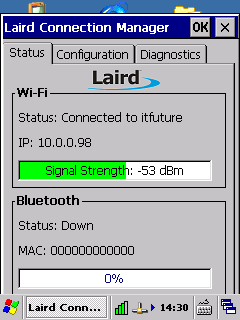

2) Switch to the third tab "Wireless Information" and select the network you want to connect to from the list of networks in range.
3) Tap "Connect".

4) Enter the Wi-Fi network password in the "Network Key" field.
5) Confirm "OK"

6) Now the terminal should connect to the network. You can check the settings of the assigned address on the first tab "IP Information".
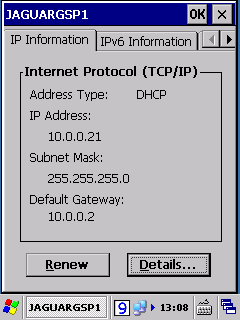
If you need the terminal to connect to multiple different networks, you will need to set up the so-called Autoprofile.
1) There is a signal strength icon on the bar to the left of the clock. If you don't see it, you can scroll through the icons using the blue arrows. Once you find the icon, double click on it and the Laird Connection Manager will open.
2) In the manager, move to the second tab "Configuration".
3) Here, click on the "Manage Profiles" button.
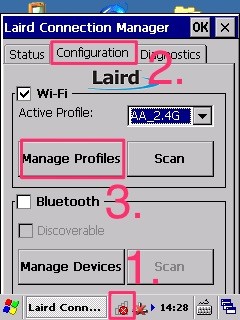
4) Go to the "Globals" tab and scroll down to the end of the table to the "Autoprofile" entry.
5) Switch the "Autoprofile" item to "On".

6) Now go back to the "Profile" tab, where you can select which networks you want the terminal to automatically connect to by ticking the checkbox. You can find out how to set up a network connection and create a profile in the "[WinCE] Wi-Fi Connection Settings (Laird module)" tutorial.
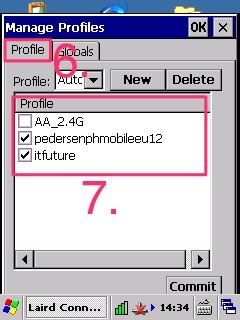
1) You must first insert a SIM card into the terminal. It is necessary that the card does not require a PIN code.
2) When ready, start by selecting AppCenter from the main desktop.
3) Select the Autostart tab in the menu and enable the WCDMA service to start automatically. After this step, we can close this menu.

4) The next step is to set up the connection itself.
5) Click on the system menu icon (Windows icon in the bottom left corner) and then click on "Settings" and "Network and Dial-up Connections".
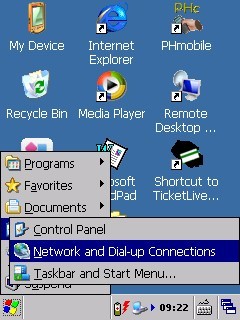
6) Long press "WCDMA" to bring up the menu. Then select the "Properties" option.

7) Next, press the "Configure..." button and the "Call Options" tab.
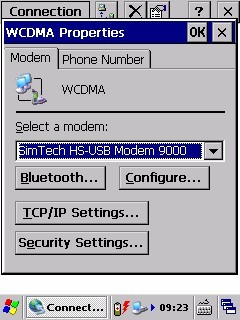
10) On this screen, the last line is important to us. Here you need to overwrite the "3gnet" entry with "Internet".
11) Confirm the change of settings by pressing the "OK" button.
12) Once the settings are complete, the terminal must be restarted to start the service. This way we have the terminal properly set up to use the 3G connection.
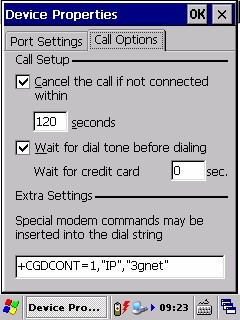
1) If you find that the barcode scanner stops responding to button presses, the most common problem is with the C_Emulator application. The C_Emulator application operates the barcode scanner and needs to keep running in the background. You can tell that the application is running by its icon in the bottom bar (Figure 1). If you don't see the icon, try using the blue arrows to scroll through the icons on the bar. If you find the icon and C_Emulator is running, you need to look elsewhere for the cause.





A fundamental feature of the Android OS is its openness, which can be a nuisance in industrial use. If you're looking for a solution that can lock your device to a specific application that you can't leave. Or if you are using a web application and need to lock your device to a specific browser window, then we can recommend a solution from 42Gears (https://www.42gears.com).
The SureLock app
(https://www.42gears.com/products/surelock/surelock-android/) allows you to lock your device to one or more specific apps. This prevents unwanted use of the device for non-work purposes. It can also collect information about device usage.
The SureFox app (https://www.42gears.com/products/surefox-secure-browser/surefox-android/) is a web browser with enhanced capabilities to restrict access to websites. It restricts the user from using the device other than as intended.